Tech Portal
Tech Portal
10GigE, 25GigE & 100GigE Vision for all Applications
High-Speed Vision Technologies
The focus of this article is going to be on the technologies involved in high-speed applications. These include interfaces, processing technologies, software and the cameras.
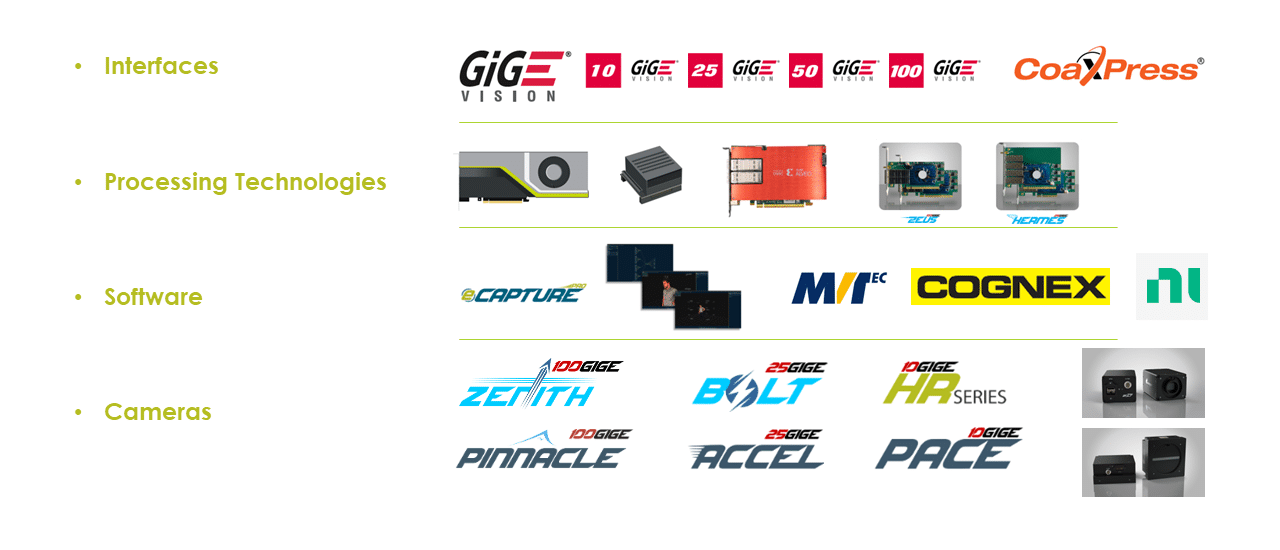
Figure: Various technologies involved in a high-speed camera system.
Video: 10GigE, 25GigE, and 100GigE Machine Vision Cameras Open New Doors in Automation.
High-Speed Imaging Interfaces – Optimized GigE Vision + GVSP
- True zero copy
- Uses header splitting(HS) in OTS NICs
- Full kernel bypass
- HS in use for SMPTE 2110 in M&E market
- Supported by industry processing cards
- Lowest latency and jitter
- No resends or flow control required (nor needed) with quality implementation
- Remains GigEVision compliant
- PTP Support
GigEVision(or Ethernet) and CoaxPress(or CXP) are seen as the primary interfaces for high-speed vision.
We will start with GigEVision. Optimized GigEVision uses header splitting in hardware available in OTS performance NICs and other processing devices. This is the same method used in SMPTE 2110 in the massive M&E markets which also has 0 tolerance for data loss. In this market, they rely on well designed receivers and as such the OTS NICs provide header splitting technologies that are used in streaming implementations like SMPTE 2110 but also in message and connected protocols like RDMA/RoCE.
We work with the same vendors who support RDMA/RoCE to use header splitting to achieve the most feature-rich and highest-performance receiver while adhering to the current and highly mature GigE Vision specification.


Figure (top): Data path in an optimized implementation of GigEVsion.
Figure (bottom): Partners of Emergent Vision Technologies.
High-Speed Imaging Interfaces – CXP over Fiber
Why CXP over fiber?
- CXP standard and coax cable were never suitable for high speeds
- CXP standard and coax cable was never suitable for long cable lengths
How has GigE technology adapted to accomplish the highest speeds?
- Firmware and software changes to OTS NICs

How has CXP technology adapted to accomplish the highest speeds?
- Completely new interface, protocol, hardware, firmware, standard managed by a small group of proponents within the machine vision industry.
- Completely new frame grabbers, firmware and software to support Fiber based CXP

When will I see CXP over fiber products?
- A very small handful of companies are involved in the specification and products are coming slowly both on the camera and frame grabber side.
- Initial products are 40G QSFP+ which is the simplest of implementations since it simply creates 4x 10G lanes. The major switch vendors consider 25G as the new 10G, 50G as the new 40G and then there is 100G. 40G is already being considered outdated technology with 25G, 50G, and 100G providing the best density and price/performance ratios.
- Even slower will be the adoption of 50G, 100G and beyond which is already available NOW in Emergent Ethernet based cameras with complete accessory portfolio. Emergent 25G cameras have already been available for 5 years and 10G cameras for over 10 years. Emergent 100G cameras have been shipping into the highest performance systems for 3 years.
Here is what a 12x 25G camera system would look like with Ethernet vs CXP12. The Ethernet solution has 12 25GigE cameras, a switch for PTP synchronization and multiplexing the 12 cameras onto dual 100G links, and finally the single slot 100G dual NIC for placing the image frames in system memory or to GPUs. The equivalent CXP solution has the cameras of course but utilizes 3x CXP12 Quad frame grabbers to accomplish the same task.
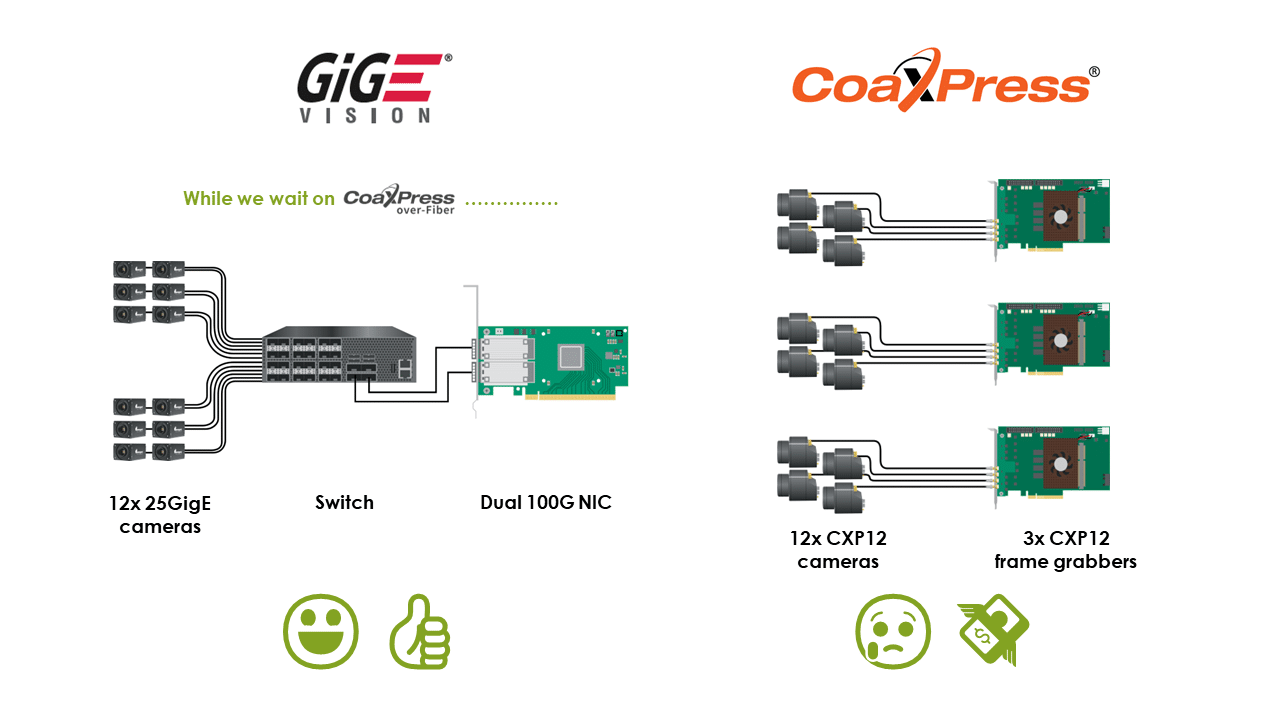
Figure: Switch-based GigE Vision system vs frame grabber-based CoaXPress system.
Here is what a 2x 100G camera system would look like with Ethernet vs CXP12. The Ethernet cameras plug directly into the 100G dual NIC for a single slot solution. The CXP12 cameras need many multiple CXP cables to plug into the required 4x CXP12 Quad frame grabbers to accomplish the same task. We will note again that this is in theory as no cameras like this exist to date. The common theme here is that CXP adoption for higher speeds is very slow.

Figure: 1x ethernet card vs 4 x frame grabbers.
High-Speed Imaging Interfaces – Convergence of the Interfaces
This section is an illustration of how the proposed or ratified changes are converging the interface standards. USB remains mostly the same but is a point to point technology. CXP has adopted the Ethernet physical layer converging towards GigEVision. GigEVision+RDMA and GigEVision+TCP (if and when ratified) is converging to CXP and USB as a point to point technology. (perhaps 2 years out). GigEVision+GVSP will maintain its integrity and feature set and not converge with the other protocols.
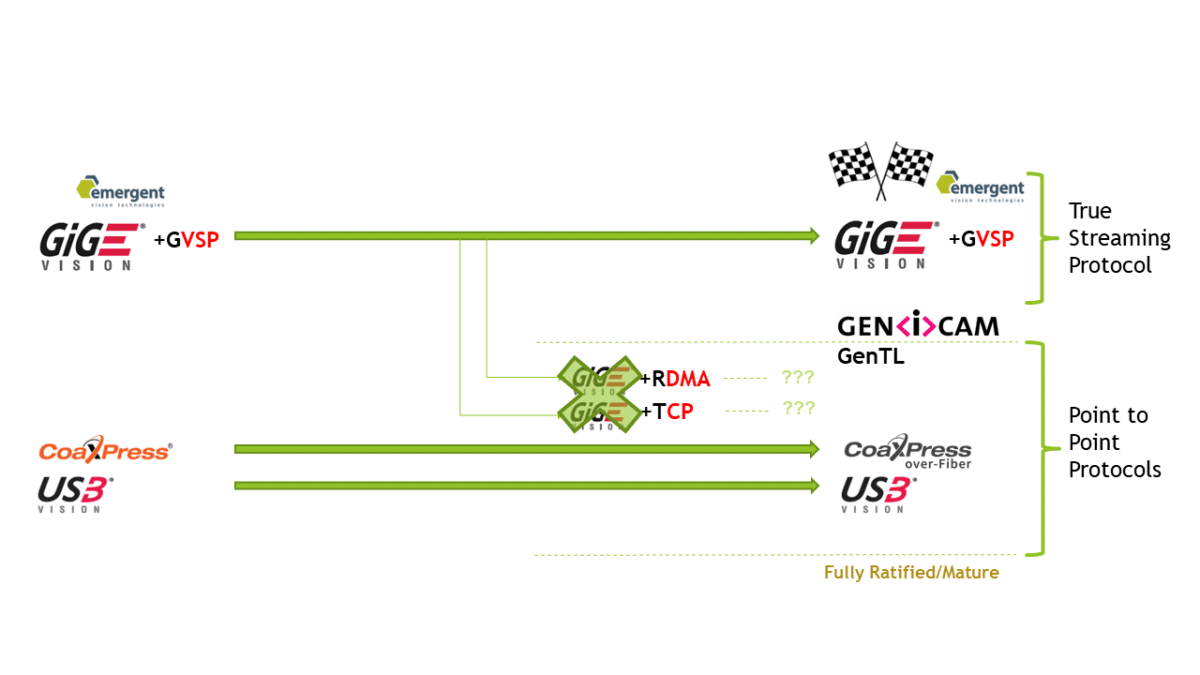
Figure: Only GigEVision + GVSP stands out as the true streaming protocol.
Processing Technologies
So, let’s say we now have our data safe in system memory by whatever means. Now, what do we do with it? For some applications, the CPU and system memory are sufficient resources. For other performance applications using multiple 100GigE, 25GigE or even 10GigE cameras, real-time processing requires offloading the task to more well-suited processing nodes. CPUs and their system memory often cannot cope. Technologies designed to help here are…
- GPU Cards – all processing done on card
- FPGA Cards – all processing done on card
- GPU Direct – bypass system memory to GPU
- Peer to Peer Transfers – move data node to node
- AI Engines – features of GPUs and FPGA cards
- NIC market converging with HPC
- Storage and Switch Solutions
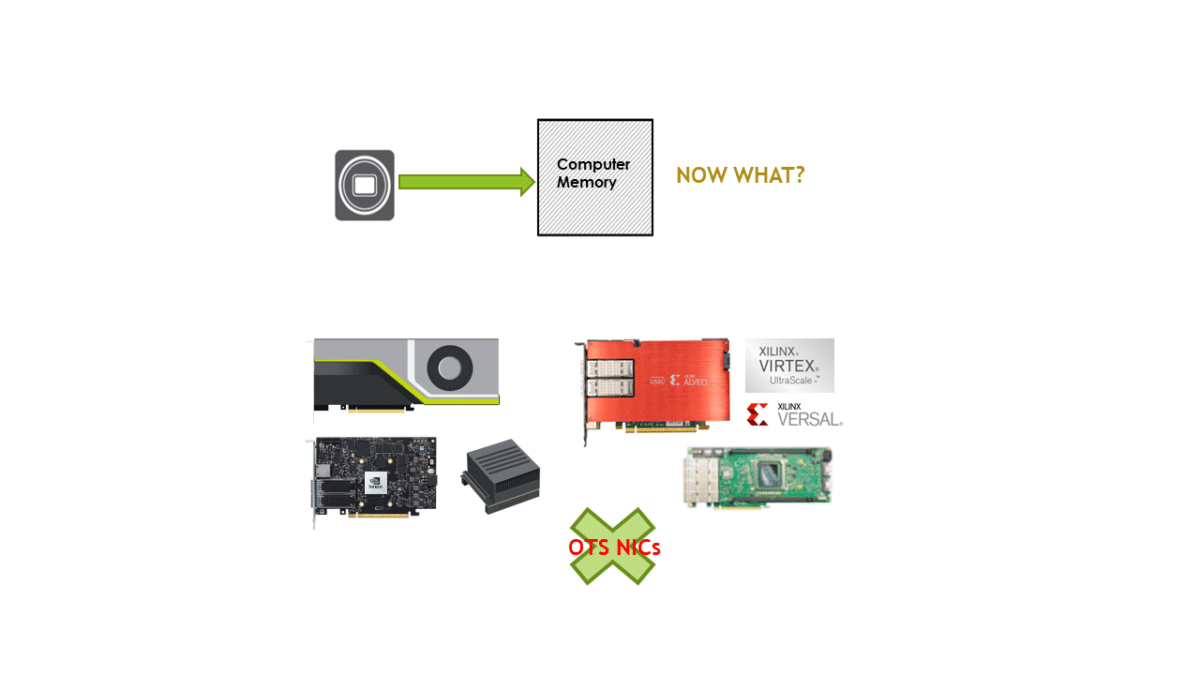
Figure: Off-the-shelf NICs cannot process pixel data and simply pass the pixel data through to the system.
Processing Technologies – GPU Cards/Modules
- 0 CPU and 0 System Memory bandwidth
- NVidia product requires Rivermax for Windows
- NVidia requires partnership – select few
- Linux is open for GPU direct on std GPUs
- 80% MV application on Windows
- Some apps include AOI, drone, VR, sports
- Lowers PC requirements
- Peer to peer support
- Available NOW!
GPU Direct is a fantastic technology and in use by many of our customers in AOI, drone, VR and sports applications to name a few. In this case, the CPU and system memory remain untouched while the data is transferred directly to the GPU from the NIC. In one deployed real-time application, 24x Emergent 25G cameras are transferring images direct to GPU where H.264 compression is being performed before passing the compressed images to the final destination. This is an implementation involving 2 100G dual NICs, 2 GPUs, and ONLY a single server. In this case the CPU and system memory is barely touched and there is absolutely 0 data loss. Emergent has supported these technologies for over 2 years.
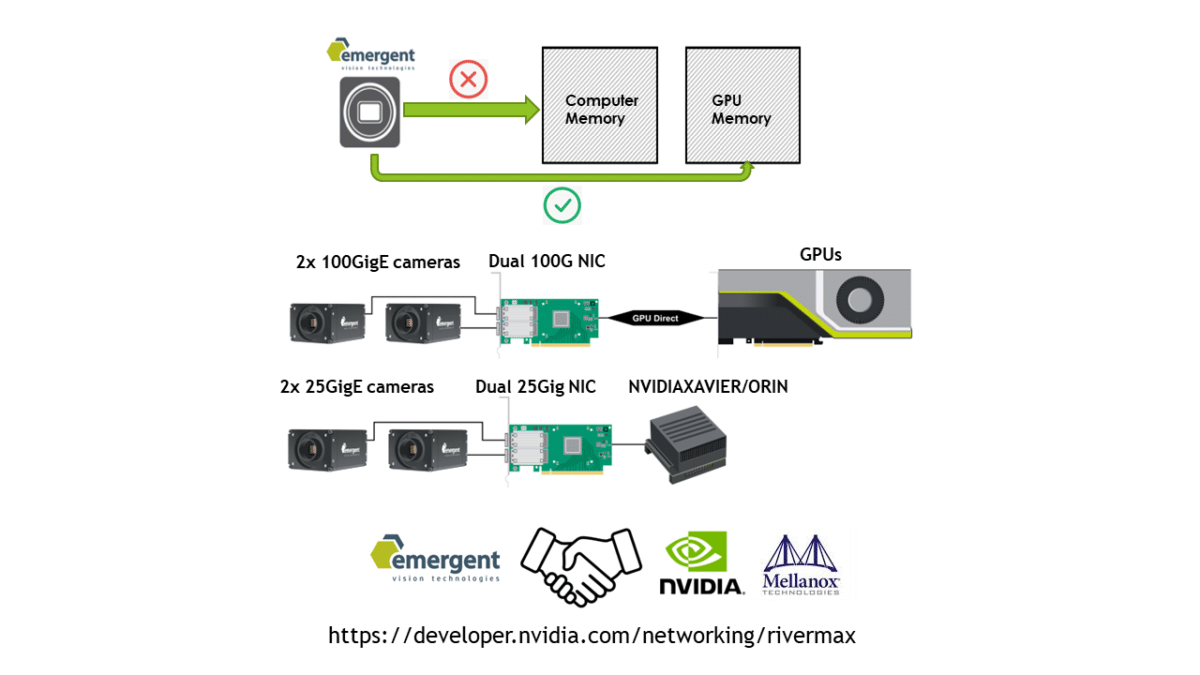
Figure: GPU Direct passes pixel data straight to the GPU bypassing CPU and system memory.
Video: GPU Direct + HZ-65000G 100GigE demo.
Video: NVidia Xavier + HZ-21000G 100GigE.
Processing Technologies – FPGA Cards
- 0 CPU and 0 System Memory bandwidth
- CPU not involved at all
- OTS FPGA Cards with native Emergent provided GVSP core support or with OTS GVSP cores from Xilinx, etc.
- MV algorithms in abundance
- Windows and Linux support
- Lowers PC requirements
- Peer to peer support
- Available NOW!
One of the nice things about Ethernet is the vast cross-industry resource pool we can draw from. Xilinx is one such vendor we work closely with to provide advanced processing resources. To integrate with Emergent cameras, a customer could take their current GigEVision core and port this to one of many cards like Xilinx Alveo which already has the same interface as our cameras. For those new to GigEVision drivers, we can provide ported firmware and drivers for cards like these to get you up and running quickly and let you focus on the particulars of your application. With a quick search, you will become aware of the abundance of FPGA code resources at your disposal. These technologies are also not limited to a single video stream but can handle multiple streams limited only by the device resources.
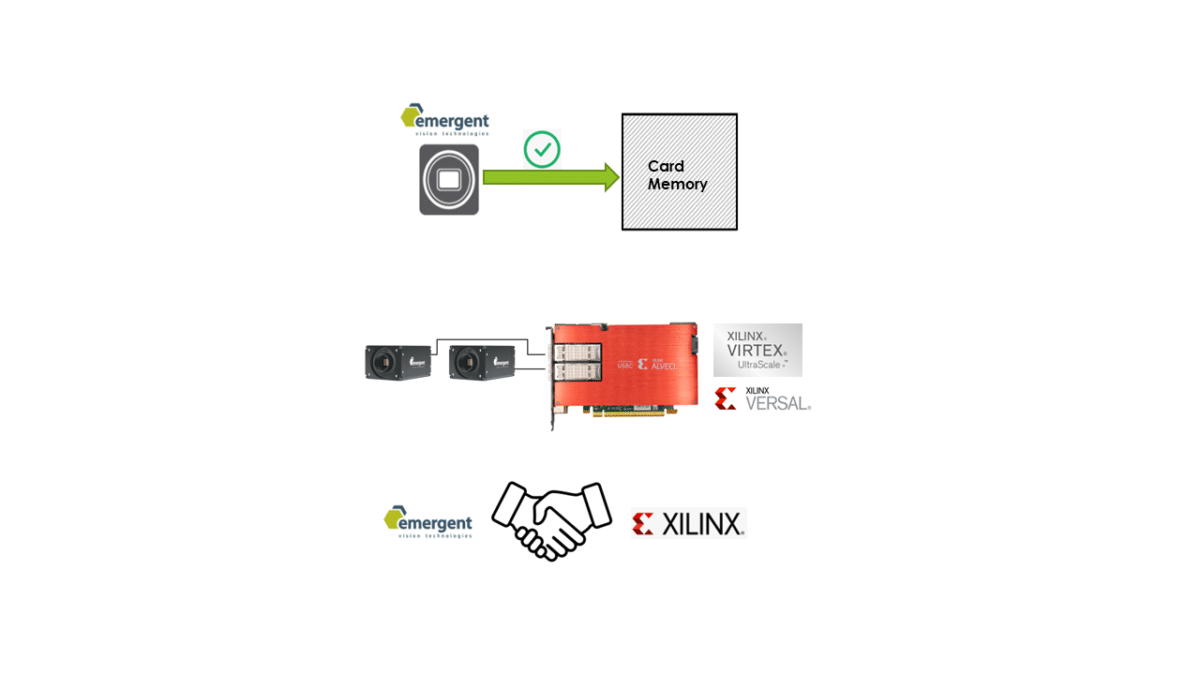
Figure: Emergent cameras seamlessly integrate with Xilinx Alveo.
Processing Technologies – Emergent NICs
- GVSP support
- Windows and Linux support
- Lowers PC requirements
- GPU Direct support
- Peer to peer support
- Front port trigger
- Full supply chain control
- Intelligent image routing
- First in series of smart NICs for MV
- Available NOW!
Emergent begins its foray into the PCIe card space which provides certain benefits to our customers like intelligent image reordering, routing,
and expanded buffers. In addition, we have customers that wish to avoid switches in their setups with cameras spaced far apart and at distances suitable for fiber. Yet, they still want tight synchronization. Our front port trigger with action command for image triggering satisfies this need. Developing our own cards also allows us to manage the full supply chain for our typical customer applications as well as maintain strict quality control. Emergent will also look to develop advanced processing cards to fulfill the needs of our customers as well as application specific modules to reduce time to market. These technologies are also not limited to a single video stream but can handle multiple streams limited only by the device resources.
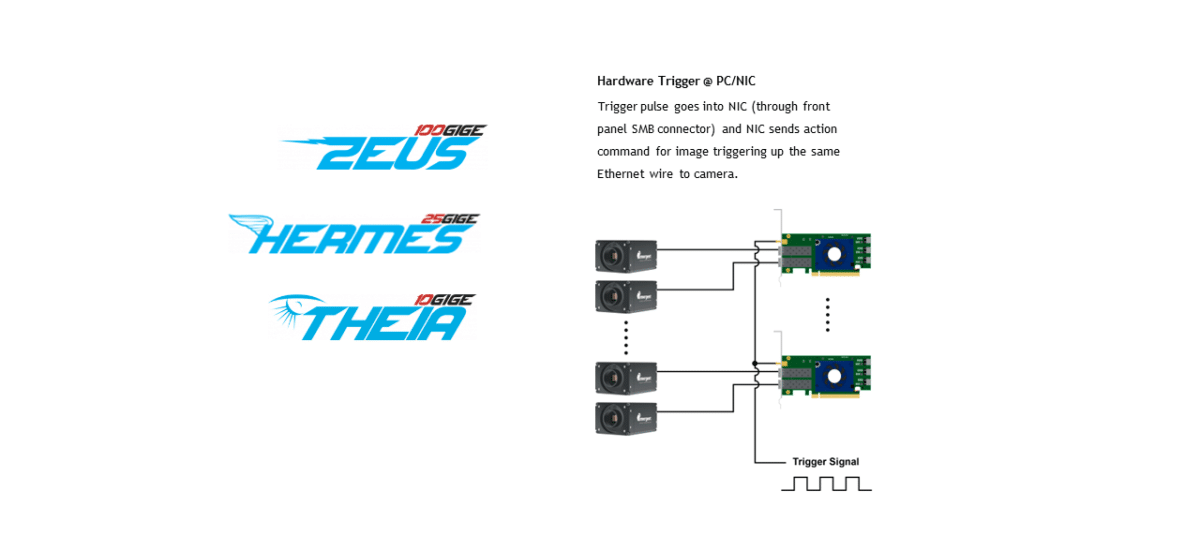

Figure: Emergent’s own PCIe cards enable management of the full supply chain for data delivery.
Processing Technologies – Storage/Switches
- Highest performance single PC solution
- Highest density solution
- IT department comprehensible technologies
- Windows and Linux support
- Lowest cost multi-camera setup
- Turnkey eCapture software support
- Customize with GPU or FPGA processing nodes
- Easily scalable to multiple servers andprocessing nodes
- 0 data loss
- H.26x Compression Options
- Available NOW!
We have presented this setup during a few online presentations as well as at trade shows like NAB Vegas and also at Vision Show in Stuttgart this past month. The system is by far the highest performance and highest density solution in the market. The system has 0 data loss taking in 210 Gbps of image data and storing it to 8 x U.2 NVMe drives. The server is a single mid range AMD and Asus server configuration that runs our eCapture Pro performance software. Some customers wish to take this setup and add GPUs in the available slots to perform real time processing.
We have customers who have scaled systems up to 250+ cameras in a single system using our 25GigE cameras – this exemplifies the ease of scalability.
As mentioned, we have customers that wish to avoid switches in their setups. Switches can be more costly starting at about $7,000 for a 48port/25G+8port/100G configuration through our partner network but help to reduce the overall system cost substantially. Smaller configurations like 18port/25G+4port/100G are available as well. The switch market is also getting more competitive as more companies come to market with 25G/100G and PTP support. You can count on Emergent for support in switch supply and configuration.

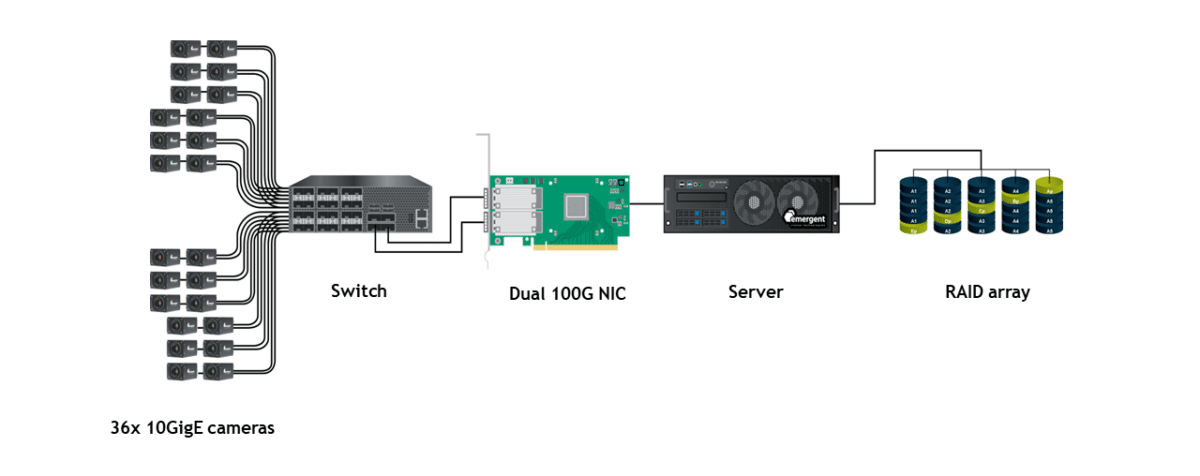
Figure (top): Partners of Emergent Vision Technologies.
Figure (bottom): Anatomy of a 36 x 10GigE camera system.
Video: Demo of 36 x 10GigE camera system.
Software – Emergent eCapture Pro and eSDK
eCapture Pro is built on top of Emergent’s eSDK and is the glue that allows us to achieve the highest performance in the market. Processing node technologies are being added and supported for custom performance deployable systems.
Available NOW!
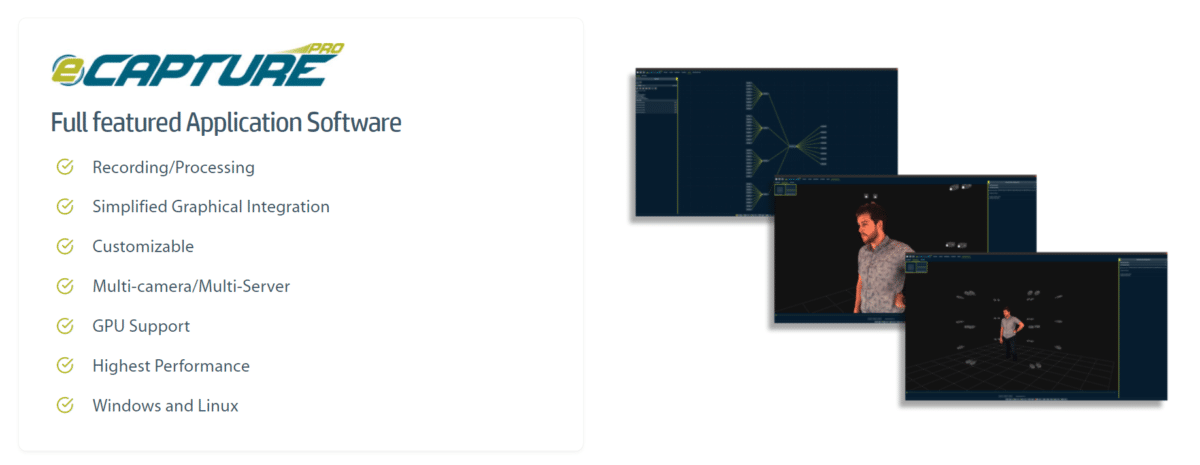
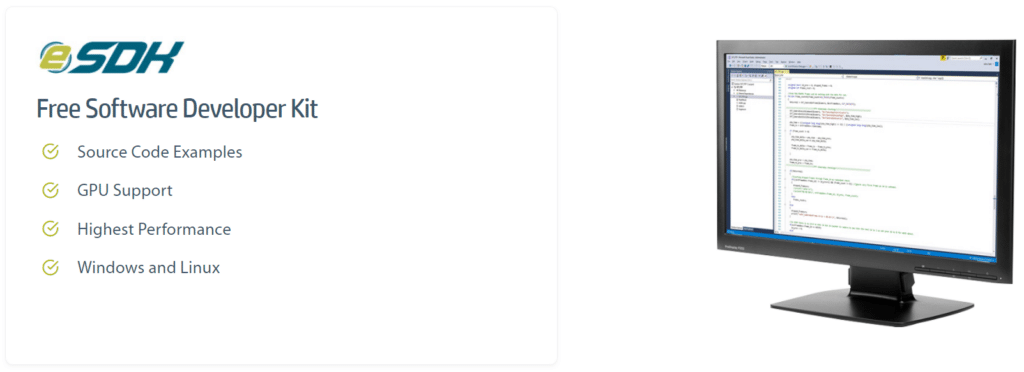
Figure: eCapture Pro and eSDK, Emergent’s full featured application software.
Software – 3rd Party
- GenTL Support for PerformanceCognex AIK Support
- MVTec Halcon support
- NI Labview support
- …and more
- Available NOW!

Figure: 3rd part machine vision software.
Area Scan Cameras
- Full Featured
- 0.5MP up to 150MP
- Highest Possible Frame Rates
- ie. 2MP @ 3462fps, 10MP @ 1000fps
- Color, Mono, UV, Polarized, NIR, SWIR
- 10GigE, 25GigE, 100GigE
- Available NOW!

Figure: Emergent’s high-speed Area-Scan camera models.
Line Scan Cameras
- Full Featured
- 4K up to 16K
- Highest Possible Line Rates
- ie. 4K @ 172KHz, 16K @ 400KHz
- Encoder Support
- TDI, Mono, Color
- 10GigE, 25GigE, 100GigE
- Available now or Coming Soon!
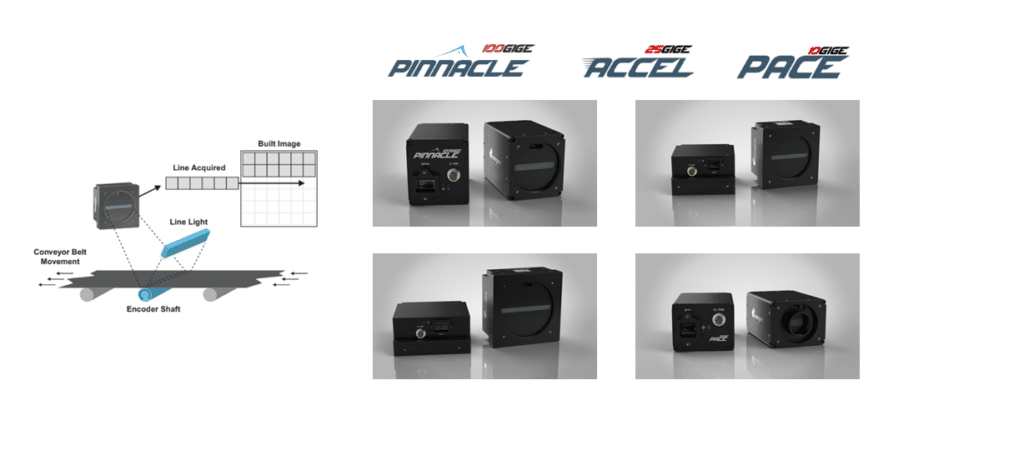
Figure: Emergent’s high-speed Line-Scan camera models.
Competition
911/112 CALL ☎: 5 x 5GigE cameras on a single PC – “2 years trying to fix and never did.”
911/112 CALL ☎: 8 x 10GigE cameras on a single PC – “Never tested more than 2 per PC”
We would like to provide a couple of examples where customers have come to us reporting a poor experience with another vendor’s high-speed camera products.
In one such recent example, we have 5 x 5GigE cameras on a single PC. Over a 2-year period, the vendor made many attempts to resolve dropped frame issues but never could. In another example, the customer was trying to run 8 x 10G cameras on a single PC. The vendor’s comments were they had never tested more than 2 cameras per PC. Both of these customers are now happily using Emergent products.
There are two very disturbing problems here:
- One is the poor performance some vendors are offering for their high-speed camera products.
- The other is that a vendor would actually sell multiples of 8 cameras without having a discussion about what the customer’s goals are to ensure the product can meet their needs.

FAQ
What are the benefits of Ethernet switches in camera applications and are they not cost-prohibitive?
Firstly, switches that we test regularly and recommend to customers are 48x25G+8x100G and 18x25G+4x100G port counts and these are priced at less than $10,000 through our partner network.
The use of switches greatly benefits applications requiring redundancy, distributed processing, camera multiplexing and PTP synchronization and thus can provide significant system cost savings in particular for multi-camera count systems as we can multiplex many cameras onto single servers which are too often limited in PCIe slots – CXP can not multiplex cameras so PCIe slots are quickly consumed with frame grabbers which results in multiple additional servers to now accommodate.
What are the highest-performance examples of processing tech seen in applications using your cameras?
NVidia GPUs are scaling in performance quicker than we can keep track of. One such customer application is providing real-time H.264 compression on 24 25GigE cameras using 2 100G dual NICs and 2 GPUs in a single server. Dedicated codec chips on GPUs handle massive amounts of computation. We use GPU Direct here to eliminate CPU and system memory usage.
AMD/Xilinx have their Alveo FPGA cards which we are working with for a few key customers and these cards are being used to process massive amounts of images from our highest-speed cameras in real-time.
Is CXP better than GigE to avoid dropped frames or lost data with high-speed cameras?
CXP as a protocol does not provide better performance on its own. CXP relies on large image buffers in the frame grabber to limit dropped frames. But for continuous operation, these buffers, regardless of size, will eventually overflow if the server cannot handle the data throughput. In addition, the more these buffers are utilized, the more latency and jitter are created which is often undesirable especially in real-time machine vision applications.
The cards Emergent uses and recommends also have large buffers to eliminate dropped frames completely for most servers. Couple this with our best-in-class performance software and drivers. But as with CXP, not all servers have suitable performance and Emergent has the expertise to provide pre and post-sales guidance to ensure project success.
What gives Emergent the edge over its competitors in high-speed camera applications?
Certainly, the fact that we are well ahead of the rest with mature performance products covering speeds from 10G up to 100G is an enormous advantage.
Our dedication to high-speed imaging with Ethernet technologies 10GigE and higher and all things associated with the complete system keeps Emergent incredibly focused and a valuable asset to our customers.
But, beyond the tech, when customers run into issues, and regardless of the issue, we have an excellent track record for extremely quick issue resolution regardless of the complexity.
Can CXP frame grabbers be used for camera image processing? And the same question for GigE cards?
Currently, this is not the case. CXP frame grabbers are used primarily for image acquisition. CPUs are most often used for image processing and rarely some GPU offloading. GPU Direct on Windows is not available. FPGA cards are very rarely used.
In contrast, the Ethernet NICs we support are very commonly used with GPUs and GPU Direct and Windows and Linux. And FPGA cards already have an Ethernet interface like our cameras and are being used as we speak for the highest performance processing.
About Emergent Vision Technologies

Here is a recap of what Emergent is all about…
- 10+ Awards for innovation and pioneering the high speed GigEVision imaging movement
- 10+ years shipping 10GigE cameras with more than 140 models
- 5+ years shipping 25GigE cameras with more than 55 models
- 2+ years shipping 100GigE cameras with more than 16 models
- Camera technology performance leader
- Focused on high-speed Ethernet/GigEVision
- Focused on enabling the processing of high-speed image data
- Area scan and Line scan models
- UV, NIR, Polarized, Color, Mono models for multispectral applications
- Emergent eSDK for full application flexibility
- Emergent eCapture Pro and 3rd Party support for highly comprehensive software solutions
- Most comprehensive range of product and support for high-speed imaging applications
- Any speed, any resolution, any cable length
- Available NOW!
We are a multi-award winning company with a focus on high speed GigEVision product.
We have many years shipping product ranging in speeds from 10GigE up to 100GigE.
We have a strong focus on providing end-to-end technologies and support for our customers applications.
We can fullfil most application needs.
Lastly, products presented are available now.
Adoption of 10GigEVision and Higher
Here is a quick snapshot of the adoption of GigEVision products ranging in speeds from 10GigE up to 100GigE. Emergent has shown how top performance can be achieved and opened up many markets including machine vision to the use of such technologies. Some companies are just now leveraging our efforts toward releasing 25G and higher speed products but still a ways to go to release ratified and performance products.
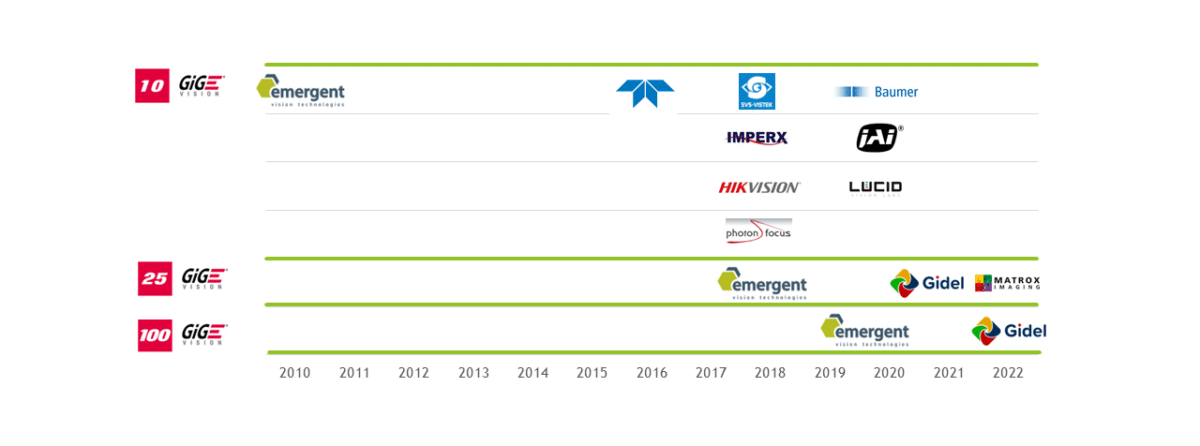
Figure: Emergent Vision Technologies is the first provider of cameras based on 10GigE, 25GigE, 50GigE, and 100GigE interfaces.

